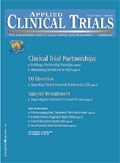Reusrgence Continues to Elude the EU
Applied Clinical Trials
The European pharma industry struggles to regain its former prowess in R&D.
When the European Forum for Good Clinical Practice (EFGCP) starts to express concerns over the prospects for the pharmaceutical industry in Europe, it is time for everyone to start worrying.

Peter O'Donnell
Alarming statements from associations representing the European pharmaceutical industry are a matter of course—it is almost their job to spread warnings. EFGCP, that much more thoughtful platform on science and ethics, has until now tended to stay close to its clinical practice roots, from which it sprang over a decade ago. But its 2006 Annual Conference in late January focused on the broader question of the chances of seeing Europe regain its former prowess in medicines research and development.
"Since the end of the last century Europe has clearly lost its leading role in research and development of medicines to the United States," says EFGCP in flagging up its anxieties. And under the title "Retooling European Medicines Development for Leadership," it debated the effectiveness of the many national and pan-European initiatives undertaken over the last five years to stop or reverse this trend.
Making Europe competitive
The meeting took place too late for its outcome to feature in this column (although doubtless there will be much to say about it in a future issue). This month's copy deadline does at least make it possible to offer a snapshot of the latest official assessment of the European Union's competitive capacity.
January saw the publication of a report from the European Commission on how successfully the 25 EU member states are reforming their economies so as to deliver on the "Lisbon Agenda" (that five-year-old dream of making Europe a world leader again in economic growth and innovation). And the central conclusion is that Europe is still not getting there. As European Commission President José Manuel Barroso said, "Progress is still uneven."
On a visit to the University of Technology in Delft—the home of the father of microbiology Antony Van Leeuwenhoek—Barroso confirmed that some of the long-term trends for science, research, and technology are "alarming," with a growing tendency among multinationals to transfer their research operations out of Europe to other countries. "The warning signals are there," he said, and "there is no time to lose." He urged "a new impetus" to increase Europe's research and development and innovative capacity. "It is especially important to have more leading companies working in areas like information and communication technology, space, nanotechnology, and biotechnology," he insisted.
The commission's proposed remedies include boosting investment in education, research, and innovation and easing operating conditions for smaller firms. Investment in higher education should by 2010 be stepped up to 2% of GDP from the current 1.28% (one way is by removing barriers to universities seeking complementary private funding). Already this March, every member state should set a clear target for overall R&D expenditure for 2010, and up to 25% of state aids and EU funding should be spent on R&D. In 2007 there should also be a European Institute for Technology and an autonomous European Research Council, which will invite bottom-up proposals from scientists without any thematic or national constraints, with a budget of at least $1 billion a year.

More Investments and Researchers Needed
The average time for setting up a business should be cut in half by the end of 2007 and then cut to one week or less, the commission recommends. By 2007, member states should each set up a "one-stop shop" to assist future entrepreneurs so that businesses can fulfill all administrative requirements in one place. Every member state should also set up a system to properly measure administrative burdens. And the commission will ease its own rules for state aids to smaller firms.
But these are just proposals. None of this will happen unless the 25 member states give their agreement at the EU summit in March. Until then, it is—as Barroso's speechwriter might express—just a whiff of pie in the blue sky on the far horizon.
Research assistance
One of the central elements of the EU's bid to sharpen its competitive edge is its research program, which over the past five years has plowed some $20 billion into supporting European projects ranging from stem cell research to materials science. It is designed to help compensate for deficiencies in market-led research in Europe, by bringing dynamism into regional and national research, spreading excellence, combating fragmentation, and reinforcing national research capacities by stimulating cross-border cooperation. Participants are willing to invest additional own resources to give them access to a wider set of knowledge and research outputs—and the pooling of competencies and resources increases the likelihood of breakthroughs.
But the new five-year program, which is supposed to be up and running by the start of 2007, is in big trouble—as European Commissioner for Science and Research Janez Potocnik had to admit when he spoke to European Parliament's research committee in late January. "As you know," he said, "the EU Council agreement did not represent all that we wanted for research" (a reference to the long-awaited and closely fought compromise that EU leaders reached at their summit last December on the EU's medium-term spending plans).
Although EU leaders explicitly and clearly recognized that EU research is "one of the most promising and effective drivers of innovation and growth," they allocated only a limited budget for it and took so long to reach any agreement at all that preparations are now lagging dangerously behind. The calendar for adoption of the next research program "is now extremely tight," Potocnik remarked in an explicit plea to the Parliament not to hold agreement up any further.
Just days before, during a symposium in Karlsruhe, Germany, on support for researchers in Europe, Potocnik identified another problem that needed urgent solutions. "Investment in EU research does not really make sense without sufficient, well-trained researchers in the European Union," he said. "Without researchers, Europe will not be able to secure and expand its role in science, technology, and innovation." So his plans also include giving the researchers' profession and career a higher status in Europe.
Meanwhile, an EU-sponsored expert group chaired by the former Finnish Prime Minister Esko Aho also came up with a plan during January for what Europe needs in the research field to significantly boost growth and employment. This too focuses on ideas such as the creation of innovation-friendly markets, strengthening R&D resources, and fostering a culture that celebrates innovation. It urges the creation of a Pact on Research and Innovation, to be signed by political, business, and social leaders to show their commitment to creating an innovative Europe, and through which the proposed strategy could be implemented.
Harsh reality
Against this widespread recognition for the need to boost EU research—notably in high-tech medicines—the harsh reality is that the EU is doing very little about it, other than issuing warnings and political declarations.
There are few signs of energetic European action in response to longstanding pharmaceutical industry concerns on pricing and reimbursements of medicines in most EU member states, on the depredations of parallel trade in Europe, or on the slow compliance of member states with the European legislation that might benefit the industry.
Recent weeks have seen some small gestures, such as reductions in European Medicines Agency fees for handling marketing authorization applications for smaller firms. European Commission Vice President Günter Verheugen, who is responsible for industry affairs, said at the time: "Smaller firms contribute much to innovation in the biotech and pharmaceutical sector. Fostering the competitiveness of those small but dynamic players is one concrete way to achieve our growth and jobs strategy, and also to support the development of new medicines." The European Commission has also released some new funds for avian flu research—a second tranche of $20 million, which includes provision for human health measures such as clinical research on pandemic influenza vaccines.
But the crucial deficiency lies elsewhere. Whatever the European Commission does, the real remedies depend on what the 25 EU member states choose to do. And over and above their reluctance to commit money to research programs in general, some indication of their readiness to act in support of the pharmaceutical industry at the European level can be gauged from a couple of recent examples.
Luxembourg is now facing action before the European Court of Justice because of its persistent failure to bring in EU rules on biotechnological patent protection—after five years of delay. Germany and France are in similar trouble for repeated failure to comply with judgements by the European Court of Justice from 2004 condemning them for failing to give effect to one of the key EU laws on biotechnology products—which should have been in place in 2002.
The simple truth is that until the member states become serious about making Europe work, there is little prospect of anyone else making it work either. And it is difficult for the clinical trials community in Europe to see clearly ahead if the principal agents of its destiny are, to mix a Barroso-esque metaphor, random and double blind.
Peter O'Donnell is a freelance journalist who specializes in European health affairs and is based in Brussels, Belgium.

Improving Relationships and Diversifying the Site Selection Process
April 17th 2025In this episode of the Applied Clinical Trials Podcast, Liz Beatty, co-founder and chief strategy officer, Inato, discusses a number of topics around site engagement including community-based sites, the role of technology in improving site/sponsor relationships, how increased operational costs are impacting the industry, and more.